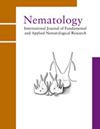Molecular and morphological characterisation of some arabica coffee-associated parasitic nematodes in Gera and Gomma districts of southwest Ethiopia
IF 1.2
4区 生物学
Q2 ZOOLOGY
引用次数: 1
Abstract
A study of coffee rhizospheres collected from six coffee fields in the Gera and Gomma districts of Jimma Zone, southwest Ethiopia, revealed the presence of 12 genera of plant-parasitic nematodes, including Belonolaimus, Criconemoides, Cryphodera, Discocriconemella, Helicotylenchus, Longidorus, Ogma, Paratylenchus, Rotylenchus, Scutellonema, Tylenchorhynchus and Xiphinema. The genera Criconemoides, Helicotylenchus, Longidorus, Paratylenchus, Tylenchorhynchus and Xiphinema were the most prevalent, detected in all soil samples with up to 1590 individuals 100 ml−1 soil for Cryphodera. Morphological and molecular analysis of three genera with higher densities revealed a single species of an unknown Cryphodera sp., Paratylenchus leptos and Tylenchorhynchus cf. zeae occurring in all soil samples. Cryphodera is reported for the first time in Africa. Molecular analyses also revealed the presence of Xiphinema citricolum and several unknown species comprising one Discocriconemella sp., one Paratylenchus sp., four Helicotylenchus spp., two Ogma spp., one Rotylenchus sp. and three Xiphinema spp. In total, 32 partial 18S, 74 D2-D3 of 28S, three ITS sequences of ribosomal DNA and 24 partial mitochondrial COI gene sequences of 16 nematode species were generated. This study demonstrates that the identities of several potentially harmful nematodes are not well known, even in relation to highly important crops such as coffee.埃塞俄比亚西南部Gera和Gomma地区与阿拉比卡咖啡相关的一些寄生线虫的分子和形态特征
一项对埃塞俄比亚西南部Jimma区Gera和Gomma区六个咖啡地采集的咖啡根际的研究表明,存在12属植物寄生线虫,包括Belonolaimus、Criconemoides、Cryphodera、Discocriconemella、Helicotylenchus、Longidorus、Ogma、Paratylenchus、Rotylenchus、Scutellonema、Tylenchorhynchus和Xiphinema。Criconemoides属、Helicotylenchus属、Longidorus属、Paratylenchus属、Tylenchorhynchus属和Xiphinema属最为普遍,在所有土壤样本中检测到多达1590个Cryphodera 100 ml−1土壤个体。对密度较高的三个属的形态学和分子分析显示,在所有土壤样本中都存在一种未知的Cryphodera sp.、Paratylenchus leptos和Tylenchorhynchus cf.zeae。Cryphodera在非洲首次被报道。分子分析还揭示了CiricomXiphinema和几个未知物种的存在,包括一个Discocriconemella sp.、一个Paratylenchus sp.、四个Helicotylenchus sp.、两个Ogma sp.、,产生了16种线虫核糖体DNA的3个ITS序列和24个线粒体部分COI基因序列。这项研究表明,几种潜在有害线虫的身份尚不清楚,甚至与咖啡等高度重要的作物有关。
本文章由计算机程序翻译,如有差异,请以英文原文为准。
求助全文
约1分钟内获得全文
求助全文
来源期刊

Nematology
生物-动物学
CiteScore
2.60
自引率
33.30%
发文量
67
审稿时长
3 months
期刊介绍:
Nematology is an international journal for the publication of all aspects of nematological research (with the exception of vertebrate parasitology), from molecular biology to field studies. Papers on nematode parasites of arthropods, and on soil free-living nematodes, and on interactions of these and other organisms, are particularly welcome. Research on fresh water and marine nematodes is also considered when the observations are of more general interest.
Nematology publishes full research papers, short communications, Forum articles (which permit an author to express a view on current or fundamental subjects), perspectives on nematology, and reviews of books and other media.
 求助内容:
求助内容: 应助结果提醒方式:
应助结果提醒方式:


